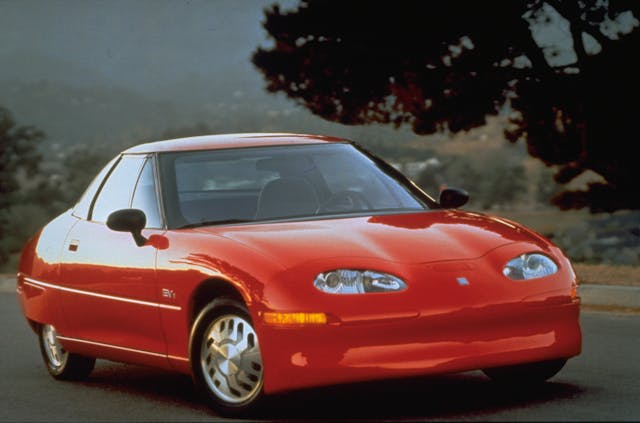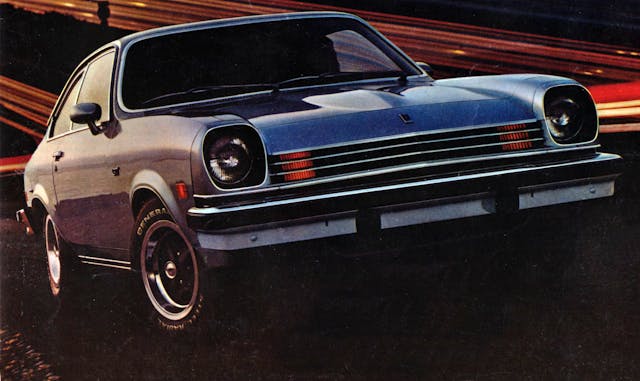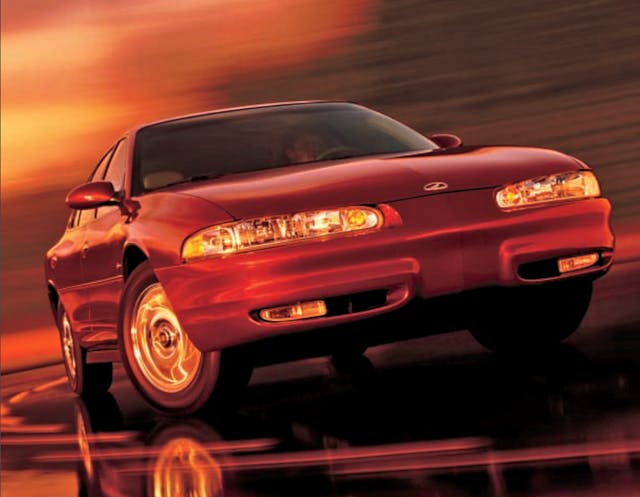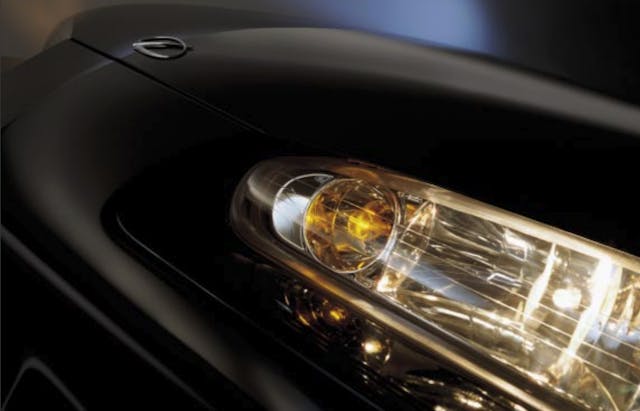Media | Articles
9 tragically flawed GM vehicles whose heroic fixes came too late
Decades upon decades passed when General Motors could do no wrong, and the products rolling off its assembly line were proof positive of its business model’s supremacy. But nobody’s perfect, and mistakes had to be addressed to meet stockholder’s expectations. GM’s design and engineering teams made some great cars with serious potential that were packed with tragic flaws—and received heroic fixes that came right before their curtain calls. It’s all rather tragic, so here are nine examples to prove the point.
1993 Cadillac Allanté (Northstar)

You gotta give General Motors credit, because when it aims for the stars, it grabs a firehose full of ideas and shoots skyward. Take a shortened E-body coupe and turn it into a bespoke V-body, then deliver finished shells from Italy’s Pininfarina to Hamtramck via a convoy of Boeing 747s known as the “Air Bridge.” One of the biggest keys to the Allanté’s failure was the drivetrain layout (front-wheel drive does not a Mercedes SL competitor make) and the mediocre performance of Cadillac’s High Technology V-8 engines.
The lack of power was finally addressed in 1993, the Allanté’s final year, by the rocket-like thrust of Cadillac’s all-new Northstar V-8. The added grunt was competitive, but 1993 also included a heavily revised rear suspension, active dampers, and revised power-steering. As we previously mentioned, the 1993 Allanté was “finally, the internationally competitive luxury roadster its creators had envisioned … albeit six years too late.”
1988 Pontiac Fiero

One of the big problems with the Pontiac Fiero, aside from the engine fires of the early models, was the promise of sporty performance, which wasn’t realized until the last year of production. As we previously mentioned, cost-cutting sealed the Fiero’s fate well before 1988. There was simply too much parts-bin engineering: The compact X-body (Citation) front suspension was flipped 180 degrees and dropped in the back, while the front suspension was lifted from the T-body subcompact (Chevette). It’s a shame that in the Fiero’s final year the necessary suspension upgrades (new front control arms, knuckles, and an all-new tri-link rear suspension, plus a wider front track and, on WS6 models, staggered wheels) and improved brakes (four wheel vented discs) couldn’t alter the course of history. These bits were precisely what Pontiac engineers intended for the Fiero from the get-go. At least we got one year of mid-engine Pontiac Excitement.
2020 Cadillac CT6-V (Blackwing)

Hate to say it, but the Cadillac CT6 is not unlike the Cimarron before it. That’s because the last examples of Cadillac’s J-body experiment indeed improved when a 2.8-liter V-6 and five-speed manual transmission were standard equipment. Similarly, the CT6 never set the world on fire, because a flagship luxury sedan needs more swagger under the hood than a turbocharged four-cylinder could ever provide. (Yes, the CT6’s standard engine was 0.8 liters smaller than what’s on tap for a 1987 Cimarron.)
Marketplace
Buy and sell classics with confidence
The CT6 didn’t receive a proper V-8 until the 2020 CT6-V hit the scene with the similarly star-crossed Blackwing motor. Because there is still a market for upper-crust luxury sedans (think Mercedes S-Class), the CT6 deserved an optional V-8 from the start. What happened when the CT6 got it all? Both the engine and the car unceremoniously met their maker.
1917–18 Chevrolet Series D

The Series D was truly a car ahead of its time, sporting a standard overhead-valve V-8 engine that came a full 38 years before the famous small-block Chevrolet V-8. A gentleman named A.T. Stuart designed a surprisingly lightweight chassis and a rear suspension with quarter-elliptic rear leaf springs mounted in a rather radical cantilever fashion. All of which should have meant a longer production run for the Series D, so what happened? General Motors happened. It’s a safe bet that the 1917 integration of Chevrolet into General Motors ensured the premium Chevrolet V-8 could never be a threat to offerings from Oldsmobile and Buick.
General Motors EV1 (NiMH upgrade)

This one is a no-brainer: Have a look at the photo that comes with the Wikipedia definition of compliance car. The EV1 was ahead of its time and yet destined for failure. We’ve discussed the truth about this car previously, but the fact remains: The EV1 only improved toward the end, when the second generation received nickel-metal hydride (NiMH) batteries. While NiMH aren’t nearly as good as the li-ion batteries that made Tesla famous, the EV1 proves that General Motors was dead-serious about electric propulsion. And it doubled down on its efforts by improving the EV1 … before they crushed (almost) all of them.
1929–31 Viking

Based on one of GM’s first shared platforms (the ubiquitous 1926–96 GM B-platform), the Viking by Oldsmobile was a short-lived experiment in premium branding for an established automaker. While this notion was successful for Oakland (i.e. Pontiac) it didn’t work out here, or at Buick (with Marquette), or at Cadillac (with LaSalle). Well, perhaps it worked a little too well for Oakland. No matter, Viking was “built to meet growing public demand for an eight-cylinder car of General Motors quality at medium price.” Talk about irony: The Series D mentioned above was doing the same for Chevrolet a little over a decade before. GM knows market segmentation can only take it so far, but market research in the Herbert Hoover era was probably lacking a bit.
2006 Chevrolet SSR (LS2)

Chevrolet’s Super Sport Roadster was a truck with a folding hardtop, styled to be a hot take on the “Advance Design” pickups from 1947. The look was great, but it rested atop a revised GMT-360 platform (shared with the Trailblazer SUV) with a workhorse 5.3-liter V-8 (300 horsepower) that ensured the SSR didn’t perform as well as some hoped.
The combination of brilliant style atop mundane underpinnings is not unlike the Pontiac Fiero’s tragic tale, as looks weren’t enough to keep questions about SSR’s longevity at bay. The asking price was steep and sales were disappointing, but the penultimate year (2005) saw the introduction of the LS2 small block V-8 (390 horsepower) and an optional six-speed manual transmission. Could this be the reincarnation of the El Camino SS? Unfortunately not, as only 826 units were sold in 2006, even with a modest power bump (+5 for autoboxes and +10 for manuals). Perhaps the future coulda been brighter if the combination of LS2 LS6 and manual transmission was available from the get-go … or perhaps power was never the SSR’s problem.
1976–77 Chevrolet Vega

I come not to bury the Chevrolet Vega, but to praise it. The early models certainly had their problems, but like most American cars in the 1970s, a cornucopia of running changes happened behind the scenes and never got the attention they deserved. This isn’t just about big bumpers and catalytic converters, as there were presumably 264 changes in 1975 and 300 changes the year after. Our nation’s Bicentennial anniversary ushered in an honest-to-goodness five-speed manual transmission, corrosion-fighting improvements, cooling upgrades, revised chassis, larger brakes, and an upgraded rear suspension. The Vega’s final year (1977) was cleaner thanks to a revised secondary air-injection system, and the insides looked more upscale with color keyed steering wheels, steering columns, and a color-matched full console. While the Vega lived a long life (and spawned the sporty Monza/Skyhawk/Starfire/Sunbird) it’s safe to say that many of the best Vegas ever made were the last ones.
2002 Oldsmobile Intrigue

I’ll let you in on a little secret: General Motors’ long running W-body platform is rather underrated, and the best of the breed came from Oldsmobile. No other W-body has the clean, modern styling and sweated the details quite like the Intrigue. No really: I mean, just look real close at that nose!

While there was nothing particularly wrong with the Intrigue, unlike other Oldsmobiles that benefited from performance upgrades (think supercharged 3800 engines), the Intrigue died three years before the wicked 5.3-liter V-8 engine (LS4) was shoehorned into the W-body Pontiac Grand Prix GXP. If only the Intrigue GLS could have the LS4 V8 tearing up the streets, violently torque-steering its owners off the road with just a touch of the traction control button and a punch to the gas pedal. Iron fist, meet velvet glove: If only the Oldsmobile division survived long enough to make this happen!














Do a little more research. The CT6 had an available 400 hp Twin Turbo 3.0L V6 (and a 500 hp 4.2L Twin Turbo along with the 550 hp Blackwing).
Sure, but discussing the optional non-V8 engines seemed unnecessary, since we are focusing on the problem of killing the Blackwing V8 right before the vehicle itself was shuttered. That’s the point of adding the CT6 to the list, middle of the road V6s have their place and thanks for pointing them out.
I had the Premium Luxury trim on a 2018 CT6 with the 3.6L V6, and traded it for the Cadillac XT6 SUV. I really miss the styling and comfort of the full size luxury Cadillac sedan.
You left out the famous 215 cid Buick V-8 used in early Skylarks and Cutlasses. It was an aluminum block and if you used Xerex anti-freeze the coolant would eat the aluminum block.
No maker orphaned its cars as often or for as ridiculous reasons as GM.
Danny Plotkin
For years I’ve seen the EV1 purported as some sort of miraculous thing… but am I the only one on Earth that doesn’t understand why? It wasn’t even close to the first, and it’s SO ugly. Anyone? Am I the only one in the I think the EV1 deserved to die club?
Nope. You are not alone in that opinion at all.
It wasn’t so much a styling exercise as a dive into new technology. Most drivers loved the EV1 and were not easily convinced to give them up.
Your omissions are as disappointing and lazy as the misinformation also included. Come on, if you’re going to phone it in at least don’t pretend to get the facts correct.
Most articles are opinion starters, if you have facts please share them
Phil, can you supply specific corrections and/or additional information?
I wish I had enough time to point out the things other people forgot that only pertain to me. Sometimes you have to present to the majority and lump it from the rest. Great article!
The Blackwing and the Fiero.
Two of the most tragic cars from GM have to be the Corvair and the Vega, thought there are shades of differences in each being killed off. The 2nd-gen Corvairs were a superior formula to the debut models, but I suspect the Camaro rendered them as somewhat of an in-house redundancy. Had GM taken more care & pride in the early Vegas – which had nice styling & handled well – they wouldn’t be so derided today. GM seemed to periodically feel the need to re-invent the wheel, so to speak, but without adequate follow-through or support.
I agree. Thought Corvair Got a bad rap from the get go. Had a Spyder, raced it, loved it, still miss it !
Roy, you are 100% correct. As a former owner of many including a 1966 Corsa Turbo the last generation Corvair was a great handler with all independent suspension. Thanks for mentioning Corvairs. Maybe just as well they stay overlooked by mainstream.
Agree completely, with currant day upgrades this could and would be one of the best cars on the market! Owned 5nover the years and wish I had one now!
I also have a great 66 cross vert with the 180HP 4sp,driving it for 30yrs now
That would be a Corsa vert,damn spell checker!
Death trap!
1st gen Corvairs were a handful for American drivers due to the swing axles. Later ones with the double-jointed halfshafts and semi-trailing arms were very good handling cars without vices. Unfortunately, Nader made no such distinctions and the public quit buying them.
The main problem with Corvairs was an oil leak issue from the push rod tubes, by the early 1970s Viton rubber with incredible heat tolerance had been created and the main oil leak issue was solved, unfortunately Corvair production had ended by then.
1965 & 1966 were the best selling years for Corvair. Too bad that’s when the Mustang was introduced.
GM had to compete this the Camaro. NOx emissions didn’t help the hotter running air cooled engine survive.
What lazy writing.
Yeah – only 3 words, and no specifics or useful suggestions.
Reading John DeLorean’s book “On a clear day you can see General Motors” The Vega was supposed to be a short stroke big bore high reving engine. It was to compete with the Japanese cars. Accountants said no and I would say many GM fails were the accounts saving money.
My first glimpse of a Fiero on the road was a real surprise, esp. once I saw the Pontiac badge. It looked like it could be a regular person’s mid-engine sports car. What a shame it did not get the kit it needed to be more than a backwards Citation until its last year. Classic GM, snatching defeat from the jaws of victory.
I have an ‘88 Fiero GT and it is an awesome car to drive. Difficult to maintain, however, and the engine is an easy drop down and that takes a hoist.
The reputation of fires was undeserved since 60% of the purchases were women and they did not check the oil level. Oil level would get low, engine would overheat, and start a fire. The other cause of fires was the rubber strip along the front of the deck lid and leaves etc. would get stuck in there and when the deck lid would be opened the leaves were dropped down into the front of the engine and potentially could cause a fire.
The reputation was undeserved but I expected the GT Fiero to become a collectible, but it hasn’t. By now, attractive cars tend to appreciate in value but the Fiero can still be bought for the price of a box of pretzels.
Good piece, but what about the 1988-91 Buick Reatta, which started just OK but was very good by the time it was canceled for lack of consumer interest?
Gary I with you could go back and revisit your Fiero book with the entire unwashed GM story.
I know you wrote that book with the GM blessing but today there has been a great need for the entire story to be told.
The Fiero has suffered so much miss understanding because so few know the ugly inside things that went on.
I have talked to many on the program off the record and even read the papers from the meeting that killed the car.
Worse was when I was at the event they wanted to bring out the 1990 Fiero and GM slammed the door on it for fear of UAW issues.
Schinella saved the day and brought the photos for all of us to see for the first time. He was proud of that car.
The Lotus suspension fallacy hurt Goad as he designed the 88 suspension. And Few know Porsche engineering helped on the tuning.
Even now few know Shenella lifted the 1990 design for the 4th Gen Fbody. As he said it was too good to throw away. Even the dash was reused.
So much to tell and may be lost if it is never documented. So many were afraid to speak out.
Automakers remind me of Bakers that mix a perfect Cake and then for some Savings put in only half the needed yeast
You don’t use yeast in cakes.
Uwe: Is this the Uwe Schmidt from Thyssen?
You don’t include the Corvair???? The real flaw came from GM discontinuing the model after making the corrections to the suspension. This car still has incredible curb appeal.
The 1965 Corvair Corsa was a geat car. It also served as the model for the Porsche 930 Turbo, 9 years later. Flat 6 boxer motor mounted in the rear, Turbocharged, 4 speed transaxle, 4 wheel true independent suspension. It just showed what 9 years of further development could have done for the Corsa. Too bad Chevrolet couldn’t have shown what they could do.
My 1964 Spyder would run rings around the Falcon/Mustang and beat them both at the drag races.
I only disagree with the companion cars from the late 20s. I would not describe the LaSalle as a failure. It sold more cars than Cadillac most year up till it was discontinued in 1940. Unlike Packard, Cadillac did not need a entry level luxury car to stay in business. It had GM to pump money into the division. Packard had to have the 120 and later 110 to stay afloat. Very few senior Packards were sold as was the same with the senior Cadillacs. Cadillac just changed the name of LaSalles to model number 61.
I had several mid to late 1990s Cadillac Northstars mostly in ETCs and it was a very good engine except for the problem with the head gaskets and studs. I personally never had any issues, simply changed oil and filters and coolant and drove all three for more than 100K miles each. Really miss nice Cadillacs.
The head gaskets were horrible. They needed head studs but got only bolts. That would have solved the issue.
Agreed! I have a nice STS-V with 44K miles. Hope I get 100K more.
I love this assessment of the Vegas; they only two issues, the Chassis and the Engine.
I loved the Mad Men plot where viewers were kinda led to belive that Don Draper & Co were to get the all new Camaro account from GM. Turns out it was the Vega they got instead. LOL.
Chevrolet took a year an made the ultimate Vega. The Cosworth Vega was a great car, with more attention paid to details and sleeving the ill-advised cylinders, and putting a Cosworth designed head on it. The death knell came when the sticker listed the price as thousands more than a Corvette. My 1968 Vega GT had holes rusted through the tops of the front fenders in less than 2 years, for which Chevrolet gave me one (1) front fender to compensate me. And the next problem occurred on a trip to Ohio from NY, when it collapsed a radiator hose and overheated the “aluminum can” engine. Chevrolet fixed it at a dealership by changing the hose and sending me on my way. By the time I got to Ohio, it was smoking quite badly and using a lot of oil. round pistons don’t like oval cylinders. The only thing that got me out of that car with little cost to me, was when a Tornado went by and dropped coffee mug sized hail all over the top surfaces and windows. I didn’t cry when it went away.